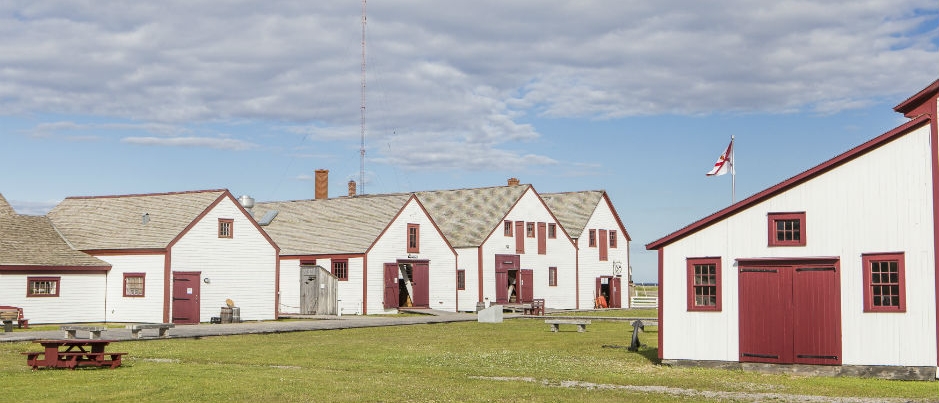The Québec maritime Blog

-
Site historique national de Paspébiac
Mathieu Dupuis
Maritime Museums and Interpretation Sites Worth Visiting
Our Recommendations to Learn More about the St. Lawrence
As you travel through Eastern Québec, you will have many opportunities to admire a unique and fascinating element of the landscape that connects our regions: the St. Lawrence River, Estuary and Gulf. Whether you drive along coastal roads, take a ferry or enjoy a picnic along the shore, you’ll undoubtedly wonder about the role this immense waterway has played in the history of our regions as well as about the marine life that lives in its waters. To learn more about the secrets of the St. Lawrence, we recommend you visit the museums and interpretation sites mentioned below, all of which focus on this majestic waterway.
The historical role of the St. Lawrence

The St. Lawrence has greatly influenced the course of history in the maritime regions of Québec as it has long been a means of transportation and source of food as well as an economic driver and key to survival. Find out more about this waterway’s important role as you explore the “Discover the New World” road trip, which showcases early European settlement in Eastern Québec, the cod fishery and the tragic deportation of the Acadians via exhibitions in five museums in Gaspésie.

The history of our regions obviously includes Indigenous peoples, who are very knowledgeable about the environment, including the St. Lawrence. The First Nations peoples helped early settlers face the challenges of their new environment through barter and the sharing of knowledge and methods. Today, you can find out more about the ancestral know-how and territorial occupation of the Innu at the Old Trading Post in Sept-Îles (Côte-Nord) and of the Mi’gmaq at the Micmac Interpretation Site in Gespeg (Gaspésie).

Another slice of history is told at the Pointe-au-Père Maritime Historic Site in Rimouski (Bas-Saint-Laurent). Thanks to the many artefacts recovered during dives and exhibited at the Empress of Ireland Museum, you can relive the fate of an ocean liner that sank in the waters of the St. Lawrence within 14 minutes on the night of May 29, 1914. This tragic event, which killed 1012 people, is Canada’s worst maritime disaster and is reminiscent of the sinking of the Titanic two years earlier. Just a stone’s throw from the museum, you can board the Onondaga submarine for an audio tour. Immerse yourself in the daily lives of the 70 crew members and learn about the workings of this massive boat that served in the Royal Canadian Navy from 1967 to 2000.
The St. Lawrence as a habitat

As you admire the St. Lawrence on the horizon, you may be surprised to learn how much life teems beneath the surface. In several areas, these waters are an ideal habitat for whales and other marine mammals. Before you participate in a whale-watching excursion at sea, you may want to learn more about these impressive cetaceans on dry land. In Tadoussac (Côte-Nord), visit the Marine Mammal Interpretation Centre (CIMM), which will introduce you to the world of the whales via various exhibitions and activities—you will even have the opportunity to learn to sing like the whales! Keep your eyes peeled, as whales can be sighted from the shore, just outside the centre.

A few kilometres east, stop at the Cap-de-Bon-Désir Interpretation and Observation Centre, one of the best places to admire whales from the shore. Inquire about the schedule of activities, such as “Ocean Encounters,” during which an interpreter guide presents various marine invertebrates that divers have brought up from the sea depths.

At the Marine Environment Discovery Centre in Les Escoumins (Côte-Nord), you may also spot whales, seals and seabirds a few dozen metres from the shore. One of the centre’s most popular activities, “The St. Lawrence Live,” gives you the opportunity to watch divers on a big screen in real time as they swim underwater in the Saguenay–St. Lawrence Marine Park. You can ask them questions* and even request that they look for a specific animal for you!

If you’re staying in the Longue-Pointe-de-Mingan area (Côte-Nord), be sure to visit the Mingan Island Cetacean Study Interpretation Centre (MICS)! Accompanied by a biologist, you can learn more about whales and find out about the team’s scientific research projects. The life-size whale sculptures and the murals in this interpretation centre are sure to impress you!

Did you know that four different species of seals live in the waters surrounding the Îles de la Madeleine? In the summer, you can see grey and harbour seals, while in the winter, you harp and hooded seals are found in the archipelago. Learn more about the fascinating world of these marine mammals by visiting the Seal Interpretation Centre.

A wide variety of experiences await you at Exploramer in Sainte-Anne-des-Monts (Gaspésie). Located along the St. Lawrence, this science museum showcases fascinating marine creatures. You can observe and even touch fish and other marine organisms in the aquarium and visit interesting exhibitions, including one about sharks! Want an even more hands-on experience? Take part in a sea excursion or fish-harvesting activity. If you’re brave enough, you may also want to participate in the “Dare to Taste” activity, which gives you the opportunity to sample marine species that have been sustainably fished or harvested.
After learning so much about what makes the St. Lawrence so unique, you’ll never see it the same way again! Enjoy visiting these places of discovery!
*The “St. Lawrence Live” activity is offered in French, but you’re welcome to ask questions in English.

(0) comment